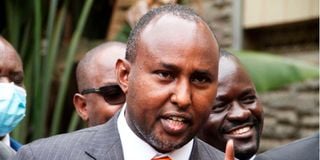Premium
From the fringes to the high table

Junet Mohamed, the Member of Parliament for Suna East.
Last week, the two coalitions that are seemingly marching toward a big face-off in the August Kenyan election — the ODM-Jubilee forces allied to President Uhuru Kenyatta and former Prime Minister Raila Odinga, and Deputy President William Ruto’s United Democratic Alliance (UDA) — tested each other in Parliament.
At issue was the Political Parties (Amendment) Bill, which creates new rules for political party coalition and registration. UDA rejects it, seeing it as little more than a trick to give a leg up to Azimio la Umoja, the emerging electoral platform born out of the Uhuru-Raila alliance.
When the contest, complete with fistfights, ended at almost 2am, Junet Mohamed, the MP for Suna East and ODM’s pitbull terrier, walked out with UDA’s collective scalp in his hand. Several folks on the Uhuru-Raila side congratulated him for a battle well fought.
Across the aisle, Junet had faced a side captained by the equally scrappy Aden Duale, the MP for Garissa Township and former Jubilee Majority Leader in the National Assembly. Down, but not out, Duale promised to return to the ring with even greater vigour when the debate resumes.
Outside Parliament, one of the most influential and controversial voices on the Kenyan political drama was lawyer Ahmednasir Abdullahi. Not one to take prisoners, the publisher of the Nairobi Law Monthly is among the new gadflies to the Establishment and a wrench in Raila’s quest for State House.
Somali population
Yet, although they might loom large, these three men are just trees in a forest. At the wider level, they are a small part of the changing Kenyan social and political architecture, but at the micro level they represent a big part of the most dramatic movements in peacetime of a once-politically and economically marginalised national groups from the periphery to primacy in the mainstream. All the three are Kenyan Somalis.
Particularly notable is the case of Ahmednasir. For, both in the classic legal domain, in the political activism theatre, and public intellectual arena, historically the “lawyercracy” that dominated these spaces in Kenya was from central Kenya and the Nyanza lakeside belt.
Sure, a defiant Dr Willy Mutunga from Ukambani got a foot in but, otherwise, it was almost always a James Orengo, Paul Muite or Githu Muigai. To cap it all, Ahmednasir snapped up the Nairobi Law Monthly, founded by then-tormented human rights lawyer Gitobu Imanyara in 1987, and which became a key instrument for the democracy movement of the time.
The Kenyan Somali book offers instructive lessons on how to work your way from the fringes to the high table.
In the 2009 national census, the Somali population was 2.3 million — an eye-popping increase of 140 per cent. Coming at a time of fear of the ascendance of Somali capital and its takeover of real estate in Kenya, it was a hot political potato. The figures were nullified on the basis that Somalis had been over-counted. By the 2019 census, the reality that the Somalis could be the largest national group in a generation became inescapable.
The point had been made. If you want to get influence, one possible path to it is the old-fashioned way: Make many babies.
Higher education
Another time-tested method of getting to the centre — into power and money — is to marry into it. The Somalis are not terribly good at that, so they took the next best path: Make money and buy your seat at the table. Leveraging a regrouped Somali diaspora scattered by the long Somalia civil war, the capital distributed through clever inexpensive payment channels, and strong family bonds and trust, they did exactly that, thus moving a record number of Somalis into the middle class.
Then, of course, there is the method parents, priests, sheikhs and everyone in between have long-prescribed for success: Go to school. The new Somali middle class, now that it had money, needed to get their children, who had fallen behind, into higher education. It happened at the time of the liberalisation of higher education of the Mwai Kibaki era, the explosion of private universities and the avalanche of evening classes at the older established campuses like the University of Nairobi (UoN).
One evening years back, I met a UoN lecturer. He was weary and, perhaps, with an eye to the far future, complained to me that 60 per cent of evening students at the university were Somali. I probed him on why he thought that was a problem and what he thought should be done about it.
After a few seconds of thought, he shrugged and said, “Nothing.” He was making the shrug out of enlightened self-interest. Since the evening classes started, his once-skinny wallet was overflowing with money from the lectures he gave and he had chased away a lot of his problems.
The political and intellectual arenas that people like Ahmednasir and Junet roll in, though, can sometimes be impervious to money and demographics. For that you need to grow sharp elbows too, which they did.
Mr Onyango-Obbo is a journalist, writer and curator of the Wall of Great Africans. @cobbo3





